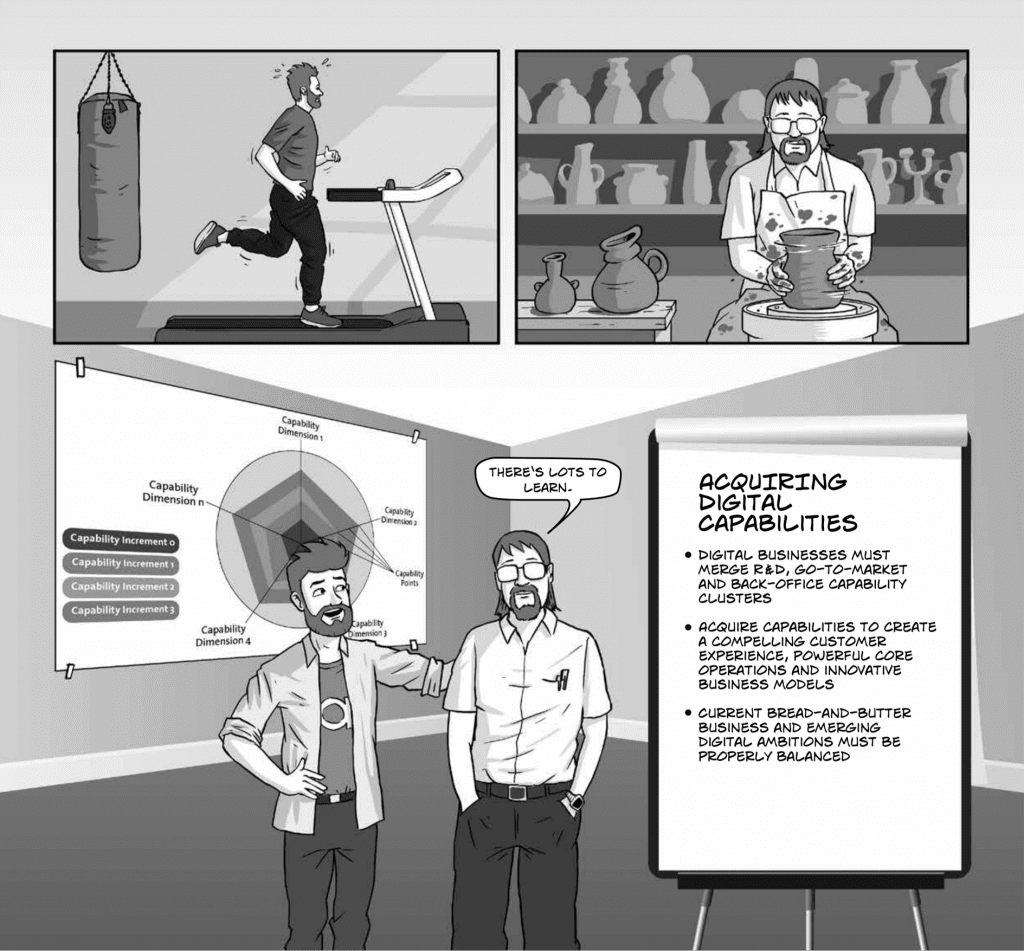‘Most of life’s actions are within our reach, but decisions take willpower.’[1]
The most common reason for organisations failing to succeed, even with good strategies, is the lack of adequate supporting capabilities needed for execution. Conversely, capability-aligned organisations perform at the top of their markets.[2] Discrete capabilities can be more easily mixed and matched compared to traditional departmental functions, resulting in a more responsive organisation (BCG study)[3] – a critical characteristic for digital success. Simply stated, ‘capability’ is the power or ability to do something. Many definitions of ‘what is digital capability’ exist in published literature[4] and these range from very narrow, i.e. use of a specific set of digital features, to being quite broad, encompassing an enterprise’s adoption of digital. Our working definition here for digital capabilities is:
‘The distinguishing capabilities of an organisation to identify and assimilate appropriate technologies, adapt its work both internally and externally, to innovate and deliver digitally enabled products and services that meet and exceed the expectations of customers in the emerging digital era.’
In this section we discuss the general aspects of digital capability acquisition – the supporting organisational and technical skills are discussed in subsequent sections. Pertinent questions with regard to digital capability acquisition are: What is an organisational capability composed of? What capabilities are needed to support digital transformation? What are sourcing choices for the acquisition of digital capabilities? How do you prioritise, in terms of time and investment, the acquisition of such capabilities? How do you assess digital capability maturity?
High-performance organisations (see the above-mentioned BCG study) display a good balance of two complementary elements of organisational capability, i.e. a ‘behavioural’ element that includes culture and roles and responsibilities (agility, innovation and risk-taking, learning, collaboration, commit-and-coordinate governance, etc.) and a ‘structural’ element that encompasses a flatter and more flexible organisational layout, with associated operating model, competencies in digital technologies (including mobile, social, data-driven, bimodal IT), physical assets (such as cloud-based on-demand infrastructure and tools) and mobilised supplier and partner ecosystems.
Three main capability clusters that have to be focused on are: research and development (R&D) capability (identification of customer needs, rapid innovation experiments, rapid scaling up of winning innovations, etc.), go-to-market (GTM) capability (product/service features and pricing, marketing, sales, post-sales service, etc.) and back-office capability (integrated information systems, shared services, high-level of automation, etc.). Capabilities must be business-relevant (i.e., not simply IT skills) and are usually recognised at a macro level, e.g., ‘rapid delivery of mobile apps’ or ‘automation of business processes’, and these macro-capabilities typically have many dimensions of supporting sub-capabilities. Using the capability decomposition style of the enterprise architecture standard TOGAF 9.1, we can depict a given capability using its component dimensions (e.g., people, process, material) and associated skills (a combination of knowledge and experience) as the figure below shows.
Often, capabilities are built up in increments. This evolution of capabilities should be tracked, for example by radar charts or dashboards, so as to guide capability acquisition.
In the book ‘Leading Digital’,[5] the authors articulate a recipe for building digital capabilities using three focus areas: creating compelling customer experience, exploring the power of core operations, and reinventing business models.
Since rapid acquisitions involve new skills, organisations must be open to both developing them internally as well as leveraging external talent (hiring new employees or consultants with specialised skills) and enabling mergers and acquisitions (M&A).
Sourcing digital capabilities may require certain changes to existing sourcing procedures.[6]
For example, a greater focus on talent (vs. cost), engagement of niche players (vs. large system integrators) and contracting for evolving project scopes with flexible terms and conditions (vs. fixed scope) are seen as more fitting for digital capability acquisition.
In order to properly balance current bread-and-butter business and emerging digital ambitions, organisational leaders must suitably identify certain parts of the organisation or activities as candidates for building out new capabilities and provide sufficient investment and attention to them with the right sense of urgency. A strategy to achieve this is to use a technique based on time horizons (short-, near- and long-term) for return on investment (ROI) and the creation of focus ‘zones’ for segregating organisational activities (see diagram above).[7] In the Sustaining Innovation column, the Performance and Productivity zones contribute to the main revenue earnings and efficiencies of the current business; in the Disruptive Innovation column, Transformation and Incubation zones provide the focus for the company to attack future markets, with fewer, faster and more drastic bets in the Transformation zone, and with a systematic and relatively wider, slower-paced portfolio of explorations in the Incubation zone. Acquisition of most of the digital capabilities falls under the zones in the Disruptive Innovation column to begin with, and the digital outcomes from these zones eventually feed the zones in the Sustaining Innovation column.
Generally speaking, each capability combines a set of organisational and technical skills.
Capabilities are, after all, organisational assets and as such they must be managed as a portfolio; their maturity must be measured from time to time and the capability-building roadmap must be updated accordingly.
This is a matter of choosing a suitable multi-level Capability Maturity Model and using the same for managing the portfolio; this is covered in the ‘Modelling for Digital’[8] book, under Digital Maturity.
_____
[1] McKee, R.: ‘Story: Structure, Substance, and the Principles of Screenwriting’, HarperCollins, 2010.
[2] Osak, M.: ‘Why companies should be organized by capabilities and not functions’, The Financial Post Online, 2013.
[3] Roghé, F., Toma, A., et al.: ‘Organizational Capabilities Matter – Organization of the Future: Designed to Win’, bcg.perspectives, pp. 6-8, 2012.
[4] Freitas Jr., J. C., Maçada, A. C. G., et al.: ‘Digital Capabilities as Drivers to Digital Business Performance’, 22nd Americas Conference on Information Systems, 2016.
[5] Westerman, G., Bonnet, D., McAfee, A.: ‘Leading Digital: Turning Technology into Business Transformation’, Harvard Business Review Press, 2014.
[6] Daub, M., Wiesinger, A.: ‘Acquiring the capabilities you need to go digital’, McKinsey, 2015.
[7] Moore, G. A.: ‘Zone to Win: Organizing to Compete in an Age of Disruption’, Diversion Books, 2015.
[8] Krafzig, D., Deb, M., Frick, M.: ‘Modelling for Digital – Best Practices for Digital Transformation in Everyday Project Life [Practitioner Edition]’, Digital Cookbook Series, Dr. Dirk Krafzig, 2020.





